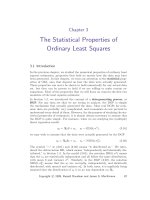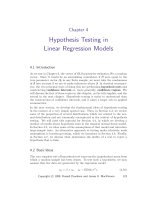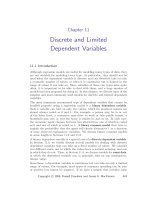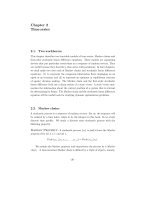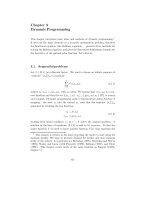Recursive macroeconomic theory, Thomas Sargent 2nd Ed - Chapter 4 ppt
Bạn đang xem bản rút gọn của tài liệu. Xem và tải ngay bản đầy đủ của tài liệu tại đây (159.71 KB, 14 trang )
Chapter 4
Practical Dynamic Programming
4.1. The curse of dimensionality
We often encounter problems where it is impossible to attain closed forms for
iterating on the Bellman equation. Then we have to adopt some numerical
approximations. This chapter describes two popular methods for obtaining nu-
merical approximations. The first method replaces the original problem with
another problem by forcing the state vector to live on a finite and discrete grid of
points, then applies discrete-state dynamic programming to this problem. The
“curse of dimensionality” impels us to keep the number of points in the dis-
crete state space small. The second approach uses polynomials to approximate
the value function. Judd (1998) is a comprehensive reference about numerical
analysis of dynamic economic models and contains many insights about ways to
compute dynamic models.
4.2. Discretization of state space
We introduce the method of discretization of the state space in the context of a
particular discrete-state version of an optimal saving problem. An infinitely lived
household likes to consume one good, which it can acquire by using labor income
or accumulated savings. The household has an endowment of labor at time t,
s
t
, that evolves according to an m-state Markov chain with transition matrix
P. If the realization of the process at t is ¯s
i
,thenattimet the household
receives labor income of amount w¯s
i
. The wage w is fixed over time. We shall
sometimes assume that m is 2, and that s
t
takes on value 0 in an unemployed
stateand1inanemployedstate. Inthiscase,w has the interpretation of being
the wage of employed workers.
The household can choose to hold a single asset in discrete amount a
t
∈A
where A is a grid [a
1
<a
2
< < a
n
]. How the model builder chooses the
– 93 –
94 Practical Dynamic Programming
end points of the grid A is important, as we describe in detail in chapter 17 on
incomplete market models. The asset bears a gross rate of return r that is fixed
over time.
The household’s maximum problem, for given values of (w,r)andgiven
initial values (a
0
,s
0
), is to choose a policy for {a
t+1
}
∞
t=0
to maximize
E
∞
t=0
β
t
u (c
t
) , (4.2.1)
subject to
c
t
+ a
t+1
=(r +1)a
t
+ ws
t
c
t
≥ 0
a
t+1
∈A
(4.2.2)
where β ∈ (0, 1) is a discount factor and r is fixed rate of return on the assets.
We assume that β(1 + r) < 1. Here u(c) is a strictly increasing, concave one-
period utility function. Associated with this problem is the Bellman equation
v (a, s)=max
a
∈A
{u [(r +1)a + ws − a
]+βEv (a
,s
) |s},
or for each i ∈ [1, ,m]andeachh ∈ [1, ,n],
v (a
h
, ¯s
i
)=max
a
∈A
{u [(r +1)a
h
+ w¯s
i
− a
]+β
m
j=1
P
ij
v (a
, ¯s
j
)}, (4.2.3)
where a
is next period’s value of asset holdings, and s
is next period’s value
of the shock; here v(a, s) is the optimal value of the objective function, starting
from asset, employment state (a, s). A solution of this problem is a value
function v(a, s) that satisfies equation (4.2.3) and an associated policy function
a
= g(a, s) mapping this period’s (a, s) pair into an optimal choice of assets to
carry into next period.
Discrete-state dynamic programming 95
4.3. Discrete-state dynamic programming
For discrete-state space of small size, it is easy to solve the Bellman equation
numerically by manipulating matrices. Hereishowtowriteacomputer program
to iterate on the Bellman equation in the context of the preceding model of asset
accumulation.
1
Let there be n states [a
1
,a
2
, ,a
n
] for assets and two states
[s
1
,s
2
] for employment status. Define two n ×1 vectors v
j
,j =1, 2, whose ith
rows are determined by v
j
(i)=v(a
i
,s
j
),i=1, ,n.Let1 be the n×1 vector
consisting entirely of ones. Define two n ×n matrices R
j
whose (i, h)element
is
R
j
(i, h)=u [(r +1)a
i
+ ws
j
− a
h
] ,i=1, ,n,h=1, ,n.
Define an operator T ([v
1
,v
2
]) that maps a pair of vectors [v
1
,v
2
]intoapairof
vectors [tv
1
,tv
2
]:
2
tv
1
=max{R
1
+ βP
11
1v
1
+ βP
12
1v
2
}
tv
2
=max{R
2
+ βP
21
1v
1
+ βP
22
1v
2
}.
(4.3.1)
Here it is understood that the “max” operator applied to an (n ×m)matrixM
returns an (n ×1) vector whose ith element is the maximum of the ith row of
the matrix M . These two equations can be written compactly as
tv
1
tv
2
=max
R
1
R
2
+ β (P⊗1)
v
1
v
2
, (4.3.2)
where ⊗ is the Kronecker product.
The Bellman equation can be represented
[v
1
v
2
]=T ([v
1
,v
2
]) ,
and can be solved by iterating to convergence on
[v
1
,v
2
]
m+1
= T ([v
1
,v
2
]
m
) .
1
Matlab versions of the program have been written by Gary Hansen, Sela-
hattin
˙
Imrohoro˘glu, George Hall, and Chao Wei.
2
Programming languages like Gauss and Matlab execute maximum opera-
tions over vectors very efficiently. For example, for an n×m matrix A,theMat-
lab command [r,index] =max(A) returns the two (1×m) row vectors r,index,
where r
j
=max
i
A(i, j) and index
j
is the row i that attains max
i
A(i, j)for
column j [i.e., index
j
=argmax
i
A(i, j)]. This command performs m maxi-
mizations simultaneously.
96 Practical Dynamic Programming
4.4. Application of Howard improvement algorithm
Often computation speed is important. We saw in an exercise in chapter 2 that
the policy improvement algorithm can be much faster than iterating on the Bell-
man equation. It is also easy to implement the Howard improvement algorithm
in the present setting. At time t, the system resides in one of N predetermined
positions, denoted x
i
for i =1, 2, ,N. There exists a predetermined class
M of (N × N) stochastic matrices P , which are the objects of choice. Here
P
ij
=Prob[x
t+1
= x
j
| x
t
= x
i
], i =1, ,N; j =1, ,N.
The matrices P satisfy P
ij
≥ 0,
N
j=1
P
ij
= 1, and additional restrictions
dictated by the problem at hand that determine the class M.Theone-period
return function is represented as c
P
, a vector of length N , and is a function of
P .Theith entry of c
P
denotes the one-period return when the state of the
system is x
i
and the transition matrix is P . The Bellman equation is
v
P
(x
i
)= max
P ∈M
{c
P
(x
i
)+β
N
j=1
P
ij
v
P
(x
j
)}
or
v
P
=max
P ∈M
{c
P
+ βPv
P
} . (4.4.1)
We can express this as
v
P
= Tv
P
,
where T is the operator defined by the right side of (4.4.1). Following Putter-
man and Brumelle (1979) and Putterman and Shin (1978), define the operator
B = T − I,
so that
Bv =max
P ∈M
{c
P
+ βPv}−v.
In terms of the operator B , the Bellman equation is
Bv =0. (4.4.2)
The policy improvement algorithm consists of iterations on the following
two steps.
1. For fixed P
n
,solve
(I − βP
n
) v
P
n
= c
P
n
(4.4.3)
Application of Howard improvement algorithm 97
for v
P
n
.
2. Find P
n+1
such that
c
P
n+1
+(βP
n+1
− I) v
P
n
= Bv
P
n
(4.4.4)
Step 1 is accomplished by setting
v
P
n
=(I − βP
n
)
−1
c
P
n
. (4.4.5)
Step 2 amounts to finding a policy function (i.e., a stochastic matrix P
n+1
∈M)
that solves a two-period problem with v
P
n
as the terminal value function.
Following Putterman and Brumelle, the policy improvement algorithm can
be interpreted as a version of Newton’s method for finding the zero of Bv = v.
Using equation (4.4.3) for n + 1 to eliminate c
P
n+1
from equation (4.4.4) gives
(I − βP
n+1
) v
P
n+1
+(βP
n+1
− I) v
P
n
= Bv
P
n
which implies
v
P
n+1
= v
P
n
+(I −βP
n+1
)
−1
Bv
P
n
. (4.4.6)
From equation (4.4.4), (βP
n+1
− I) can be regarded as the gradient of Bv
P
n
,
which supports the interpretation of equation (4.4.6) as implementing Newton’s
method.
3
3
Newton’s method for finding the solution of G(z) = 0 is to iterate on
z
n+1
= z
n
− G
(z
n
)
−1
G(z
n
).
98 Practical Dynamic Programming
4.5. Numerical implementation
We shall illustrate Howard’s policy improvement algorithm by applying it to
our savings example. Consider a given feasible policy function k
= f(k,s). For
each h, define the n × n matrices J
h
by
J
h
(a, a
)=
1ifg (a, s
h
)=a
0otherwise.
Here h =1, 2, ,m where m is the number of possible values for s
t
,and
J
h
(a, a
) is the element of J
h
with rows corresponding to initial assets a and
columns to terminal assets a
. For a given policy function a
= g(a, s) define
the n ×1 vectors r
h
with rows corresponding to
r
h
(a)=u [(r +1)a + ws
h
− g (a, s
h
)] , (4.5.1)
for h =1, ,m.
Suppose the policy function a
= g(a, s) is used forever. Let the value
associated with using g(a, s) forever be represented by the m (n × 1) vectors
[v
1
, ,v
m
], where v
h
(a
i
) is the value starting from state (a
i
,s
h
). Suppose that
m = 2. The vectors [v
1
,v
2
]obey
v
1
v
2
=
r
1
r
2
+
βP
11
J
1
βP
12
J
1
βP
21
J
2
βP
22
J
2
v
1
v
2
.
Then
v
1
v
2
=
I − β
P
11
J
1
P
12
J
1
P
21
J
2
P
22
J
2
−1
r
1
r
2
. (4.5.2)
Here is how to implement the Howard policy improvement algorithm.
Step 1. For an initial feasible policy function g
j
(k, j)forj =1,formthe
r
h
matrices using equation (4.5.1), then use equation (4.5.2) to evaluate
the vectors of values [v
j
1
,v
j
2
] implied by using that policy forever.
Step 2. Use [v
j
1
,v
j
2
] as the terminal value vectors in equation (4.3.2), and
perform one step on the Bellman equation to find a new policy function
g
j+1
(k, s)forj + 1 = 2 . Use this policy function, update j ,andrepeat
step 1.
Step 3. Iterate to convergence on steps 1 and 2.
Sample Bellman equations 99
4.5.1. Modified policy iteration
Researchers have had success using the following modification of policy iteration:
for k ≥ 2, iterate k times on Bellman’s equation. Take the resulting policy
function and use equation (4.5.2) to produce a new candidate value function.
Then starting from this terminal value function, perform another k iterations on
the Bellman equation. Continue in this fashion until the decision rule converges.
4.6. Sample Bellman equations
This section presents some examples. The first two examples involve no opti-
mization, just computing discounted expected utility. The appendix to chapter
6 describes some related examples based on search theory.
4.6.1. Example 1: calculating expected utility
Suppose that the one-period utility function is the constant relative risk aversion
form u(c)=c
1−γ
/(1 − γ). Suppose that c
t+1
= λ
t+1
c
t
and that {λ
t
} is an
n-state Markov process with transition matrix P
ij
=Prob(λ
t+1
=
¯
λ
j
|λ
t
=
¯
λ
i
).
Suppose that we want to evaluate discounted expected utility
V (c
0
,λ
0
)=E
0
∞
t=0
β
t
u (c
t
) , (4.6.1)
where β ∈ (0, 1). We can express this equation recursively:
V (c
t
,λ
t
)=u (c
t
)+βE
t
V (c
t+1
,λ
t+1
)(4.6.2)
We use a guess-and-verify technique to solve equation (4.6.2) for V (c
t
,λ
t
).
Guess that V (c
t
,λ
t
)=u(c
t
)w(λ
t
) for some function w(λ
t
). Substitute the
guess into equation (4.6.2), divide both sides by u(c
t
), and rearrange to get
w (λ
t
)=1+βE
t
c
t+1
c
t
1−γ
w (λ
t+1
)
or
w
i
=1+β
j
P
ij
(λ
j
)
1−γ
w
j
. (4.6.3)
100 Practical Dynamic Programming
Equation (4.6.3) is a system of linear equations in w
i
,i =1, ,n whose solu-
tion can be expressed as
w =
1 − βP diag
λ
1−γ
1
, ,λ
1−γ
n
−1
1
where 1 is an n × 1 vector of ones.
4.6.2. Example 2: risk-sensitive preferences
Suppose we modify the preferences of the previous example to be of the recursive
form
V (c
t
,λ
t
)=u (c
t
)+βR
t
V (c
t+1
,λ
t+1
) , (4.6.4)
where R
t
(V )=
2
σ
log E
t
exp
σV
t+1
2
is an operator used by Jacobson (1973),
Whittle (1990), and Hansen and Sargent (1995) to induce a preference for ro-
bustness to model misspecification.
4
Here σ ≤ 0; when σ<0, it represents a
concern for model misspecification, or an extra sensitivity to risk.
Let’s apply our guess-and-verify method again. If we make a guess of the
same form as before, we now find
w (λ
t
)=1+β
2
σ
log E
t
exp
σ
2
c
t+1
c
t
1−γ
w (λ
t
)
or
w
i
=1+β
2
σ
log
j
P
ij
exp
σ
2
λ
1−γ
j
w
j
. (4.6.5)
Equation (4.6.5) is a nonlinear system of equations in the n ×1 vector of w ’s.
It can be solved by an iterative method: guess at an n ×1 vector w
0
,useiton
the right side of equation (4.6.5) to compute a new guess w
1
i
,i=1, ,n,and
iterate.
4
Also see Epstein and Zin (1989) and Weil (1989) for a version of the R
t
operator.
Sample Bellman equations 101
4.6.3. Example 3: costs of business cycles
Robert E. Lucas, Jr., (1987) proposed that the cost of business cycles be
measured in terms of a proportional upward shift in the consumption process
that would be required to make a representative consumer indifferent between
its random consumption allocation and a nonrandom consumption allocation
with the same mean. This measure of business cycles is the fraction Ω that
satisfies
E
0
∞
t=0
β
t
u [(1 + Ω) c
t
]=
∞
t=0
β
t
u [E
0
(c
t
)] . (4.6.6)
Suppose that the utility function and the consumption process are as in example
1. Then for given Ω, the calculations in example 1 can be used to calculate the
left side of equation (4.6.6). In particular, the left side just equals u[(1 +
Ω)c
0
]w(λ), where w(λ) is calculated from equation (4.6.3). To calculate the
right side, we have to evaluate
E
0
c
t
= c
0
λ
t
, ,λ
1
λ
t
λ
t−1
···λ
1
π (λ
t
|λ
t−1
) π (λ
t−1
|λ
t−2
) ···π (λ
1
|λ
0
) , (4.6.7)
where the summation is over all possible paths of growth rates between 0 and
t. In the case of i.i.d. λ
t
, this expression simplifies to
E
0
c
t
= c
0
(Eλ)
t
, (4.6.8)
where Eλ
t
is the unconditional mean of λ. Under equation (4.6.8), the right
side of equation (4.6.6) is easy to evaluate.
Given γ,π, a procedure for constructing the cost of cycles—more precisely
the costs of deviations from mean trend—to the representative consumer is first
to compute the right side of equation (4.6.6). Then we solve the following
equation for Ω:
u [(1 + Ω) c
0
] w (λ
0
)=
∞
t=0
β
t
u [E
0
(c
t
)] .
Using a closely related but somewhat different stochastic specification, Lu-
cas (1987) calculated Ω. He assumed that the endowment is a geometric trend
with growth rate µ plus an i.i.d. shock with mean zero and variance σ
2
z
.Starting
from a base µ = µ
0
, he found µ, σ
z
pairs to which the household is indifferent,
102 Practical Dynamic Programming
assuming various values of γ that he judged to be within a reasonable range.
5
Lucas found that for reasonable values of γ , it takes a very small adjustment
in the trend rate of growth µ to compensate for even a substantial increase in
the “cyclical noise” σ
z
, which meant to him that the costs of business cycle
fluctuations are small.
Subsequent researchers have studied how other preference specifications
would affect the calculated costs. Tallarini (1996, 2000) used a version of the
preferences described in example 2, and found larger costs of business cycles
when parameters are calibrated to match data on asset prices. Hansen, Sargent,
and Tallarini (1999) and Alvarez and Jermann (1999) considered local measures
of the cost of business cycles, and provided ways to link them to the equity
premium puzzle, to be studied in chapter 13.
4.7. Polynomial approximations
Judd (1998) describes a method for iterating on the Bellman equation using
a polynomial to approximate the value function and a numerical optimizer to
perform the optimization at each iteration. We describe this method in the
context of the Bellman equation for a particular problem that we shall encounter
later.
In chapter 19, we shall study Hopenhayn and Nicolini’s (1997) model
of optimal unemployment insurance. A planner wants to provide incentives to
an unemployed worker to search for a new job while also partially insuring the
worker against bad luck in the search process. The planner seeks to deliver
discounted expected utility V to an unemployed worker at minimum cost while
providing proper incentives to search for work. Hopenhayn and Nicolini show
that the minimum cost C(V ) satisfies the Bellman equation
C (V )=min
V
u
{c + β [1 − p (a)] C (V
u
)} (4.7.1)
where c, a are given by
c = u
−1
[max (0,V + a − β{p (a) V
e
+[1−p (a)] V
u
})] . (4.7.2)
5
See chapter 13 for a discussion of reasonable values of γ .SeeTable1of
Manuelli and Sargent (1988) for a correction to Lucas’s calculations.
Polynomial approximations 103
and
a =max
0,
log [rβ (V
e
− V
u
)]
r
. (4.7.3)
Here V is a discounted present value that an insurer has promised to an unem-
ployed worker, V
u
is a value for next period that the insurer promises the worker
if he remains unemployed, 1 −p(a) is the probability of remaining unemployed
if the worker exerts search effort a,andc is the worker’s consumption level.
Hopenhayn and Nicolini assume that p(a)=1− exp(ra), r>0.
4.7.1. Recommended computational strategy
To approximate the solution of the Bellman equation (4.7.1), we apply a compu-
tational procedure described by Judd (1996, 1998). The method uses a polyno-
mial to approximate the ith iterate C
i
(V )ofC(V ). This polynomial is stored
on the computer in terms of n + 1 coefficients. Then at each iteration, the
Bellman equation is to be solved at a small number m ≥ n +1 values of V .
This procedure gives values of the ith iterate of the value function C
i
(V )at
those particular V ’s. Then we interpolate (or “connect the dots”) to fill in the
continuous function C
i
(V ). Substituting this approximation C
i
(V )forC(V )
in equation (4.7.1), we pass the minimum problem on the right side of equa-
tion (4.7.1) to a numerical minimizer. Programming languages like Matlab and
Gauss have easy-to-use algorithms for minimizing continuous functions of sev-
eral variables. We solve one such numerical problem minimization for each node
value for V . Doing so yields optimized value C
i+1
(V ) at those node points. We
then interpolate to build up C
i+1
(V ). We iterate on this scheme to convergence.
Before summarizing the algorithm, we provide a brief description of Chebyshev
polynomials.
104 Practical Dynamic Programming
4.7.2. Chebyshev polynomials
Where n is a nonnegative integer and x ∈ IR ,thenth Chebyshev polynomial,
is
T
n
(x)=cos
n cos
−1
x
. (4.7.4)
Given coefficients c
j
,j =0, ,n,thenth-order Chebyshev polynomial approx-
imator is
C
n
(x)=c
0
+
n
j=1
c
j
T
j
(x) . (4.7.5)
We are given a real valued function f of a single variable x ∈ [−1, 1].
For computational purposes, we want to form an approximator to f of the
form (4.7.5). Note that we can store this approximator simply as the n +1
coefficients c
j
,j =0, ,n. To form the approximator, we evaluate f (x)at
n + 1 carefully chosen points, then use a least squares formula to form the c
j
’s
in equation (4.7.5). Thus, to interpolate a function of a single variable x with
domain x ∈ [−1, 1], Judd (1996, 1998) recommends evaluating the function at
the m ≥ n +1 points x
k
,k =1, ,m,where
x
k
=cos
2k − 1
2m
π
,k =1, ,m. (4.7.6)
Here x
k
is the zero of the k th Chebyshev polynomial on [−1, 1]. Given the
m ≥ n +1 values of f(x
k
)fork =1, ,m, choose the “least squares” values
of c
j
c
j
=
m
k=1
f (x
k
) T
j
(x
k
)
m
k=1
T
j
(x
k
)
2
,j=0, ,n (4.7.7)
Polynomial approximations 105
4.7.3. Algorithm: summary
In summary, applied to the Hopenhayn-Nicolini model, the numerical procedure
consists of the following steps:
1. Choose upper and lower bounds for V
u
,sothatV and V
u
will be under-
stood to reside in the interval [V
u
, V
u
]. In particular, set V
u
= V
e
−
1
βp
(0)
,
the bound required to assure positive search effort, computed in chapter 19.
Set V
u
= V
rmaut
.
2. Choose a degree n for the approximator, a Chebyshev polynomial, and a
number m ≥ n + 1 of nodes or grid points.
3. Generate the m zeros of the Chebyshev polynomial on the set [1, −1], given
by (4.7.6).
4. By a change of scale, transform the z
i
’s to corresponding points V
u
in
[V
u
, V
u
].
5. Choose initial values of the n + 1 coefficients in the Chebyshev polynomial,
for example, c
j
=0, ,n. Use these coefficients to define the function
C
i
(V
u
) for iteration number i =0.
6. Compute the function
˜
C
i
(V ) ≡ c + β[1 − p(a)]C
i
(V
u
), where c, a are de-
termined as functions of (V, V
u
)fromequations(4.7.2) and (4.7.3). This
computation builds in the functional forms and parameters of u(c)and
p(a), as well as β .
7. For each point V
u
, use a numerical minimization program to find C
i+1
(V
u
)=
min
V
u
˜
C
i
(V
u
).
8. Using these m values of C
j+1
(V
u
), compute new values of the coefficients
in the Chebyshev polynomials by using “least squares” [formula (4.7.7)].
Return to step 5 and iterate to convergence.
106 Practical Dynamic Programming
4.7.4. Shape preserving splines
Judd (1998) points out that because they do not preserve concavity, using
Chebyshev polynomials to approximate value functions can cause problems. He
recommends the Schumaker quadratic shape-preserving spline. It ensures that
the objective in the maximization step of iterating on a Bellman equation will
be concave and differentiable (Judd, 1998, p. 441). Using Schumaker splines
avoids the type of internodal oscillations associated with other polynomial ap-
proximation methods. The exact interpolation procedure is described in Judd
(1998) on p. 233. A relatively small number of evaluation nodes usually is
sufficient. Judd and Solnick (1994) find that this approach outperforms lin-
ear interpolation and discrete state approximation methods in a deterministic
optimal growth problem.
6
4.8. Concluding remarks
This chapter has described two of three standard methods for approximating so-
lutions of dynamic programs numerically: discretizing the state space and using
polynomials to approximate the value function. The next chapter describes the
third method: making the problem have a quadratic return function and linear
transition law. A benefit of making the restrictive linear-quadratic assumptions
is that they make solving a dynamic program easy by exploiting the ease with
which stochastic linear difference equations can be manipulated.
6
The Matlab program schumaker.m (written by Leonardo Rezende of Stan-
ford University) can be used to compute the spline. Use the Matlab command
ppval to evaluate the spline.


